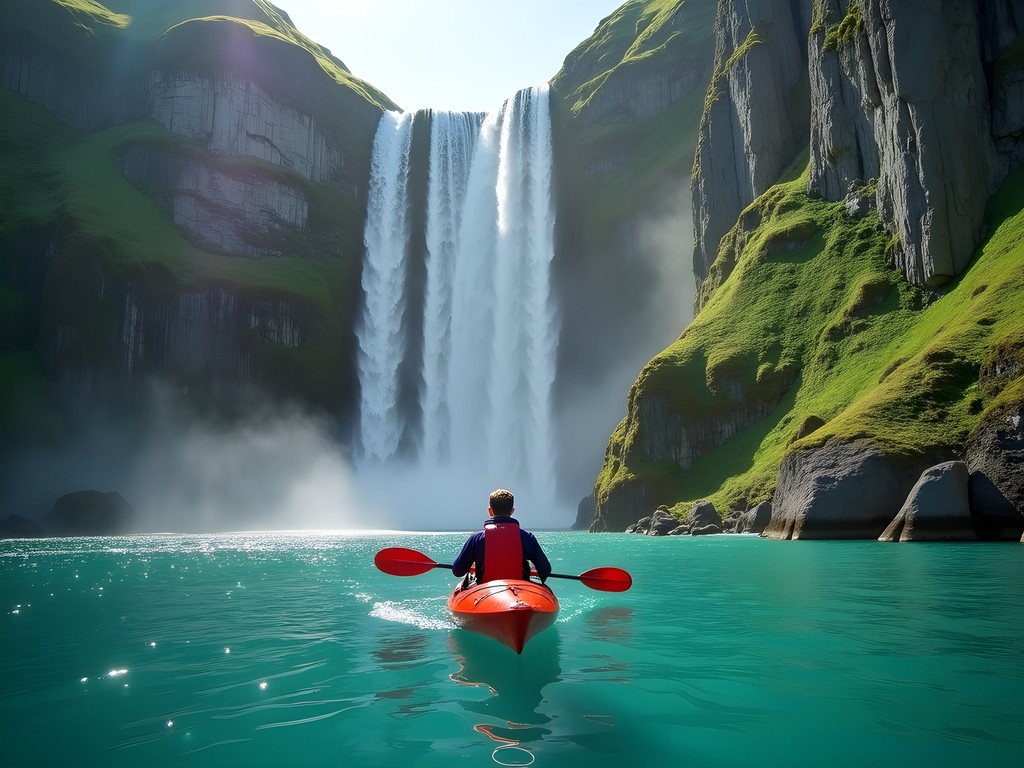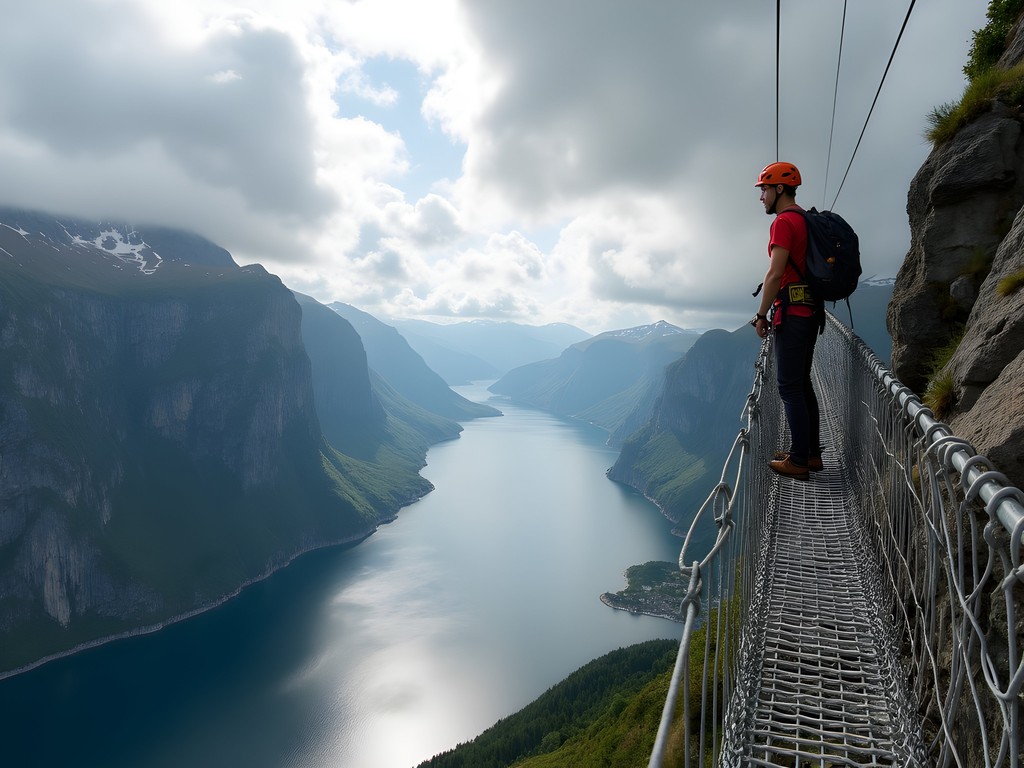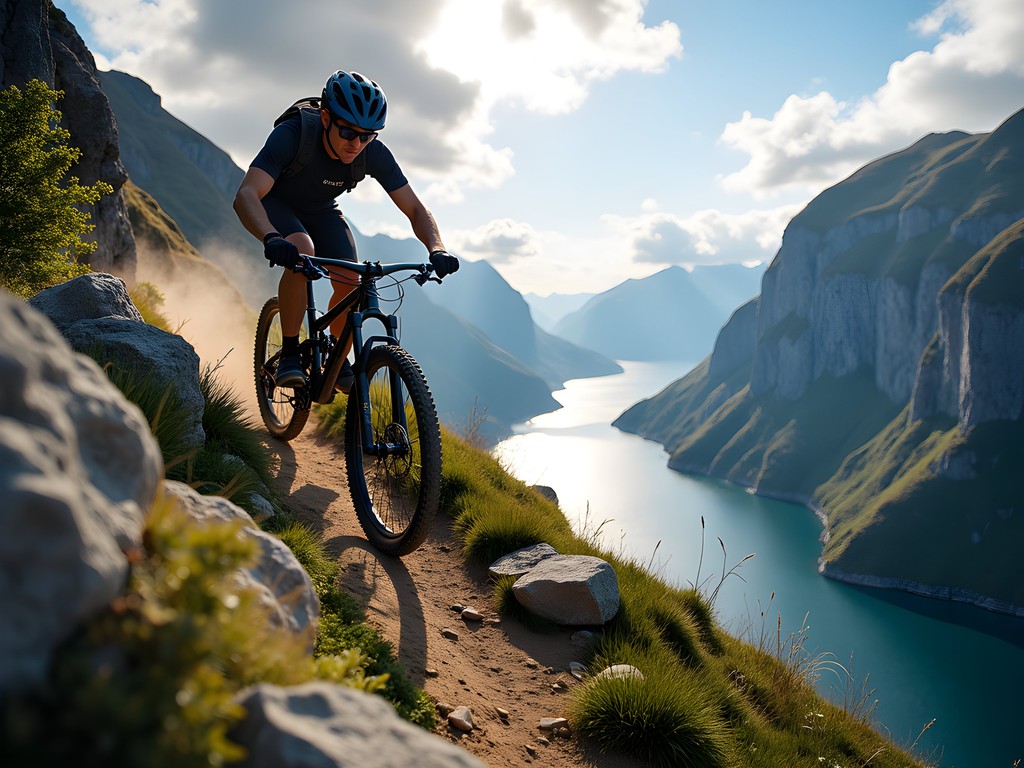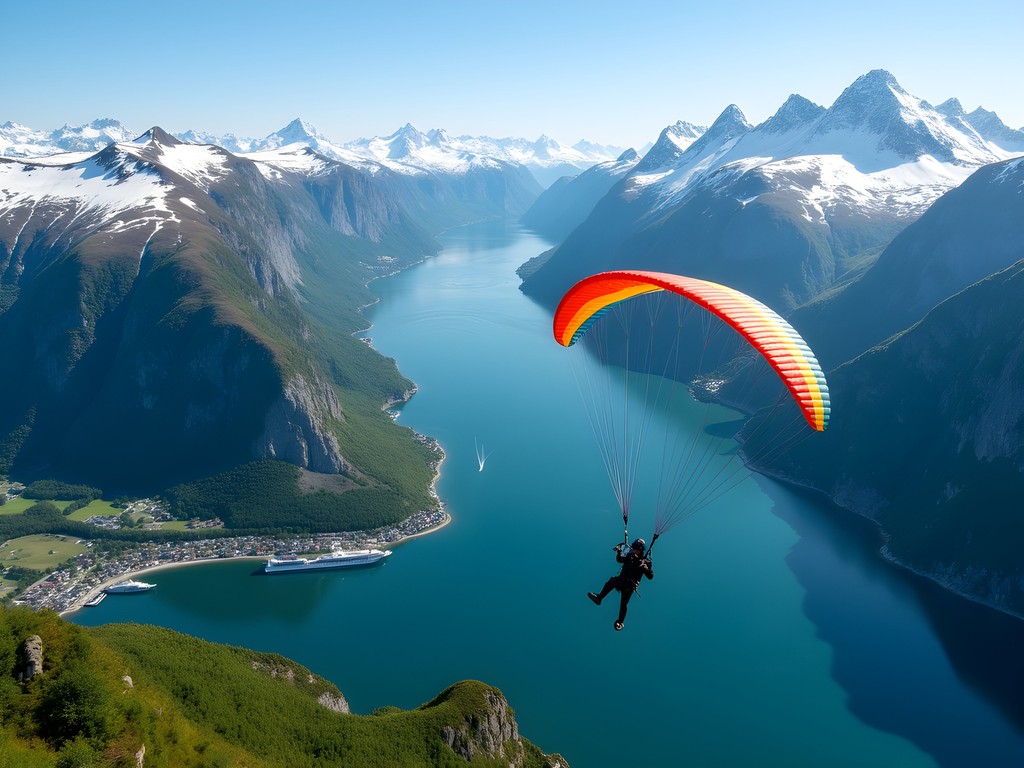Disclosure: This article contains affiliate links. We may earn a commission from purchases at no extra cost to you, which helps our travel content.
As I stood at Flydalsjuvet viewpoint, watching the morning mist dance across the UNESCO-protected Geiranger Fjord, I felt that familiar scientific curiosity merge with pure awe. This wasn't my first time in Norway—my husband's ancestral homeland has become our family's summer tradition—but this visit was different. With our children spending time with their grandparents in Oslo, I had one week to experience the fjord's most extreme adventures with my research colleagues. As an epidemiologist who spends most days analyzing data, there's something profoundly recalibrating about physically challenging yourself against nature's grandest landscapes. Geiranger doesn't just offer postcard views; it presents a laboratory of adrenaline-inducing activities that test human limits against a backdrop so magnificent it seems almost engineered for adventure. This guide distills my analytical observations and lived experiences into a blueprint for those seeking to push their boundaries in one of Earth's most spectacular settings.
Navigating the Fjord: Advanced Kayaking Routes
While tourists crowd the large sightseeing vessels, experienced paddlers can access the fjord's most dramatic features from water level—a perspective that transforms your understanding of geological scale. Having kayaked in New Zealand's Milford Sound and Japan's Miyajima, I can confidently say Geiranger offers the most technically rewarding fjord paddling experience.
I recommend a full-day expedition from Geiranger village to Skageflå farm, an abandoned mountain farm perched 250 meters above the fjord. This 22km round trip requires significant upper body endurance and weather awareness. The route passes beneath the legendary Seven Sisters waterfall—seven separate streams that plunge directly into the fjord—where crosscurrents and sudden wind tunnels demand precise paddle control.
What makes this route scientifically fascinating is paddling through what geologists call a hanging valley—a smaller valley that ends at a cliff above a larger valley. The Seven Sisters cascade from such formations, created when the main glacier carved deeper than its tributaries.
For equipment, I trusted my waterproof dry bag to protect my camera equipment and emergency supplies. The roll-top closure system proved essential when we encountered unexpected spray zones near Bridal Veil waterfall.
The most challenging section comes near the Knivsflå abandoned farm, where the fjord narrows and water conditions can change rapidly. Here, the mountains create a wind tunnel effect that requires anticipatory paddling techniques and strong group communication.

💡 Pro Tips
- Start early (6-7am) to avoid afternoon winds and tourist boat wakes
- Pack high-protein snacks in waterproof containers—you'll burn 3000+ calories on a full day paddle
- Bring polarized sunglasses to cut glare and better spot submerged rocks near shorelines
The Via Ferrata Challenge: Climbing Geiranger's Vertical World
For those with a head for heights and basic climbing experience, Geiranger's via ferrata route presents the most direct way to appreciate the fjord's geological formation. Unlike traditional rock climbing, via ferrata uses fixed steel cables, ladders, and bridges that allow reasonably fit adventurers to access terrain normally reserved for technical climbers.
The route begins near the Hotel Union and ascends over 800 vertical meters. What makes this experience uniquely thrilling is the combination of physical exertion and the increasingly spectacular perspectives of the fjord that unfold with each meter gained. As someone who studies population movement patterns professionally, I found myself analyzing the historical human relationship with this landscape—from the nearly inaccessible mountain farms to modern tourism infrastructure—all while clipped into a steel cable traversing a cliff face.
The most heart-pounding section is undoubtedly the 'Gjølmunna' suspension bridge—a narrow crossing spanning a deep ravine with the fjord visible 300 meters below. Having tested my fear response in various global adventure settings, I can confirm this ranks among the most psychologically challenging moments I've experienced. The physiological response—elevated heart rate, perspiration, heightened sensory awareness—mirrors what we observe in acute stress scenarios in my research.
Safety equipment is non-negotiable here. I invested in my own climbing harness rather than using rental gear, appreciating its comfortable weight distribution during the 5-6 hour ascent. For those with less experience, the guided option is essential—they provide technical instruction and fascinating commentary on the region's formation during rest breaks.

💡 Pro Tips
- Book at least 3 days in advance during summer high season
- Wear layers with moisture-wicking base materials—you'll alternate between sweating on exposed sections and feeling chilled in shaded areas
- Train grip strength for 2-3 weeks before attempting—forearm fatigue is the most common reason people struggle
Summit to Fjord: Extreme Mountain Biking Descents
For those who prefer wheels to paddles or climbing gear, Geiranger offers some of Europe's most technically challenging mountain biking. The region's dramatic topography creates natural gravity-fed descents that drop over 1,000 vertical meters from alpine terrain to fjord level.
The most renowned route begins at Djupvasshytta near Dalsnibba viewpoint and follows the old postal road down to Geiranger village. What makes this descent exceptional is the remarkable ecological transition zones you pass through—from sparse alpine vegetation through birch forests and finally to the lush valley floor. As someone who studies environmental impacts on health, I was fascinated by how distinctly the microclimate changes were reflected in both the flora and the riding conditions.
This isn't a trail for beginners—sections feature loose scree fields, tight switchbacks, and technical rock gardens that demand advanced bike handling skills. My research colleague Lars, an experienced Norwegian rider, described it perfectly: 'This isn't just mountain biking; it's controlled falling with occasional braking.'
The most technical section comes approximately halfway down, where the trail crosses several seasonal streams creating slick rock faces that require precise weight distribution and line choice. My mountain biking gloves proved invaluable here, providing crucial grip when my handlebars were slick with spray from crossing these waterways.
While you can arrange shuttles to the top through local outfitters, I recommend the full experience: cycling up the road first (a brutal 3-hour climb) to fully appreciate the descent. This approach also allows you to acclimatize to the altitude and assess weather conditions, which can change dramatically between valley and summit.

💡 Pro Tips
- Rent a full-suspension enduro bike with at least 150mm travel front and rear
- Pack a rain shell regardless of valley weather—conditions at higher elevations change rapidly
- Study the route thoroughly beforehand—cell service is inconsistent on the mountain
Paragliding the Fjord: Aerial Adventure Perspectives
Perhaps no adventure activity in Geiranger better combines extreme thrills with breathtaking beauty than tandem paragliding. Taking off from the Dalsnibba plateau at 1,500 meters and gradually descending to the village provides a three-dimensional understanding of the fjord's formation that no ground-based activity can match.
As a scientist, I was captivated by how clearly visible the glacial carving processes become from this aerial perspective—the U-shaped valley profile, hanging tributary valleys, and striated rock faces all tell the story of ice movement that shaped this landscape over millennia. The experience transforms abstract geological concepts into visceral understanding.
While no previous experience is necessary for tandem flights with certified instructors, this isn't an activity for those with severe vertigo or motion sensitivity. The thermal updrafts created by the fjord's microclimate can create significant turbulence, particularly in afternoon conditions. My pilot, Erik, a former Norwegian national paragliding team member, expertly used these updrafts to extend our flight to nearly an hour, teaching me about reading cloud formations and wind patterns throughout.
The most exhilarating moment comes when your pilot offers to demonstrate 'acrobatic maneuvers'—rapid spiral descents and wing-overs that create momentary weightlessness. Having studied the physiological effects of g-forces in various research contexts, experiencing them firsthand provided a fascinating embodied understanding of vestibular system responses.
Before my flight, I captured the preparation and takeoff using my action camera mounted to a chest harness, which provided remarkably stable footage even during the most dynamic flight segments. The ultra-wide angle lens perfectly captured both the wing above and the spectacular landscape below.

💡 Pro Tips
- Book morning flights (before 11am) for the smoothest air conditions
- Take anti-nausea medication if you're prone to motion sickness—the thermal cycles can be intense
- Wear layers and gloves even in summer—the temperature at launch altitude is typically 10-15°C cooler than in the village
Overnight Bivouac at Abandoned Mountain Farms
For the ultimate combination of cultural history and adventure, nothing compares to overnight bivouacking at one of Geiranger's abandoned mountain farms. These remote homesteads, perched precariously on narrow ledges hundreds of meters above the fjord, tell the story of human resilience and adaptation to extreme environments.
The most accessible (a relative term) is Skageflå farm, reached via a strenuous 2-hour hike from the fjord shore after a boat drop-off. What makes this experience exceptional is the juxtaposition of human history against raw wilderness—standing where generations of Norwegian farmers lived in near isolation, connected to the outside world only by treacherous mountain paths or boat journeys.
As someone who studies population health, I found myself contemplating the remarkable adaptive capacity of these farming communities—how they developed sustainable agricultural practices in such marginal terrain, and how isolation shaped their social structures and health outcomes. The remaining stone foundations and restored buildings provide a tangible connection to this history.
Sleeping at these elevations requires proper preparation. My sleeping system proved essential for insulation from the cold stone surfaces while adding minimal pack weight for the steep ascent. Even in summer, nighttime temperatures at elevation can drop significantly.
The most magical moment comes at sunset when the last tourist boats have departed, and the fjord falls into profound silence broken only by distant waterfalls. The quality of light as the sun sets behind the western mountains, casting the entire fjord in golden hues before transitioning to deep blues, creates a meditative atmosphere unlike anything I've experienced elsewhere in my travels.

💡 Pro Tips
- Obtain permission from local authorities before planning an overnight stay
- Pack in all supplies including water—there are no reliable sources at most farm sites
- Bring a detailed topographical map and compass as trail markings can be minimal in sections
Final Thoughts
Geiranger's extreme adventures offer more than just adrenaline—they provide unique perspectives on one of Earth's most dramatic landscapes. As both a scientist and adventure seeker, I've found that physically engaging with environments enhances my understanding of them in ways passive observation cannot. Whether you're analyzing glacial formations while paragliding overhead or contemplating historical resilience while bivouacking at abandoned farms, these experiences create multidimensional connections to place. While the activities described require advanced skills and proper preparation, the rewards transcend typical tourism experiences. As Norway continues balancing adventure tourism with environmental protection, responsible engagement with these landscapes becomes increasingly important. I return to my epidemiology work with renewed perspective—and already planning next summer's Norwegian adventure with my family, when I'll introduce my children to gentler versions of these transformative experiences.
✨ Key Takeaways
- Geiranger's adventure activities require advance booking during peak summer season (June-August)
- Physical preparation significantly enhances enjoyment—target cardiovascular endurance and upper body strength
- Weather conditions can change dramatically between fjord level and higher elevations
- Combining activities (like kayaking to trailheads) creates unique expedition-style experiences
📋 Practical Information
Best Time to Visit
June through early September
Budget Estimate
$150-300 per day including accommodations and guided activities
Recommended Duration
Minimum 5 days to experience multiple adventure activities
Difficulty Level
Challenging
















Comments
MountainBiker55
Just got back from Geiranger and tried that mountain bike descent you mentioned. Holy cow, those switchbacks are no joke! My hands were cramping from braking so much on the steeper sections. The views were worth every second though. We stopped at that little farm café halfway down for waffles - absolute lifesaver. One thing to note: the shuttle service that takes bikes up was booked solid, so reserve that well in advance if you're going in peak season!
Hunter Thompson
Those waffles are legendary! Did you try them with the brown cheese?
MountainBiker55
YES! Brown cheese and jam. Weird combo but somehow perfect after a terrifying descent!
SafetyFirst
Is there a best time of year for these activities? Wondering about weather conditions and safety.
Hazel Anderson
June through August offers the most reliable conditions. The paragliding and Via Ferrata typically don't operate in bad weather, and kayaking can be dangerous if winds pick up. Always check forecasts and listen to local guides!
FjordFan
Those paragliding photos are INCREDIBLE! Added to bucket list immediately!
Hunter Thompson
Just did the Via Ferrata last month and it was INSANE! The exposure on some sections literally had my heart in my throat, but the guides were absolute legends. That final section where you're basically hanging over the fjord? Mind-blowing. One tip for anyone planning this: definitely invest in some decent gloves with good grip. My hands were killing me by the end with the rental ones. And don't forget to look up from the cables occasionally - some people get so focused on the climbing they miss half the incredible views!
AdventureSeeker92
Was it scary? I'm thinking of doing it but I'm a bit nervous about heights...
Hunter Thompson
It's definitely intense if you have height issues, but you're clipped in the whole time so it's more about mental challenge than actual danger. The guides are super patient too. I'd say try it - might be the thing that helps you push through that fear!
Hazel Anderson
Hunter nailed it! The Via Ferrata is as much a mental challenge as physical. And yes to the gloves tip - I used my climbing gloves and they were perfect for the metal cables.
oceanbuddy
This looks amazing! How advanced do you need to be for the kayaking routes? I've only done calm lakes before, not sure if I'd be in over my head here.
Hazel Anderson
Great question! The main routes I described definitely require intermediate to advanced skills and previous fjord experience. But there are guided beginner routes that stick closer to shore if you want to build up to the more challenging ones!
oceanbuddy
Thanks Hazel! Maybe I'll try a guided tour first and see how it goes. Those views look worth it!
escapeway
Those mountain biking descents look terrifying and amazing at the same time! Anyone know the best time of year for the paragliding? And are there weight restrictions?
Hazel Anderson
Late May through September is best for paragliding, with June-August having the most reliable conditions. Most operators have a weight limit around 220-230 lbs (100-105kg). The thermal conditions in the fjord create amazing lift patterns!
sunsetace
I did the paragliding last summer! Hands down the most incredible view of my life. Wasn't cheap but 100% worth it.
Jean Wells
I completed the advanced kayaking route last summer at 58 years old, and it was one of the most rewarding experiences of my travels. The Seven Sisters waterfall section requires careful navigation, especially when the cruise ships create wake. I'd recommend going early morning (6-8am) when the fjord is calmest and the light is magical for photographs. The local outfitter provided excellent dry bags for equipment, but I wish I'd brought my own waterproof case for my camera gear. Excellent write-up, Hazel - your scientific perspective adds valuable context to the geological formations that make this place so special.
escapeway
Jean - that's inspiring! I'm 45 and was worried about the kayaking being too strenuous. Did you need previous kayaking experience for the advanced route?
Jean Wells
You'll be fine! I had done recreational kayaking maybe 5-6 times before. The guides assess your skills before choosing routes. Build some upper body strength beforehand and you'll enjoy it much more!
sunsetace
Wow, that via ferrata looks intense! Would you say it's doable for someone with basic climbing experience? Planning to visit in June next year.
Hazel Anderson
Hi sunsetace! The via ferrata has routes for different levels. If you've done some climbing before, the intermediate route should be manageable. They provide all safety gear and a guide. June is perfect timing too - less crowds than July/August!
sunsetace
Thanks Hazel! That's really helpful. Definitely adding it to my itinerary then!
starbuddy
That paragliding shot with the fjord below is absolutely incredible! Did you take that yourself?
Hazel Anderson
Yes! Had a small camera mounted to my helmet. Terrifying to operate while flying but totally worth it for that perspective!
starbuddy
Wow, major props for multitasking while paragliding! I'd be too busy screaming or passing out lol
Charlotte Watkins
This brings back memories! We visited Geiranger last year with our teenage sons (15 and 17), and it was the perfect destination to satisfy both parents and adventure-seeking teens. While the boys did the mountain biking with my husband, I opted for the more moderate hiking trails which still offered spectacular views. The Seven Sisters waterfall hike was challenging enough for me! What surprised us most was how family-friendly the area is despite being known for extreme adventures - there really is something for every ability level. We rented a cabin overlooking the fjord which gave us flexibility with meals and early morning starts. If you're traveling with family, I highly recommend splitting into groups based on adventure comfort levels rather than trying to make everyone do the same activities.
Venture X
Premium card with 2X miles, $300 travel credit, Priority Pass